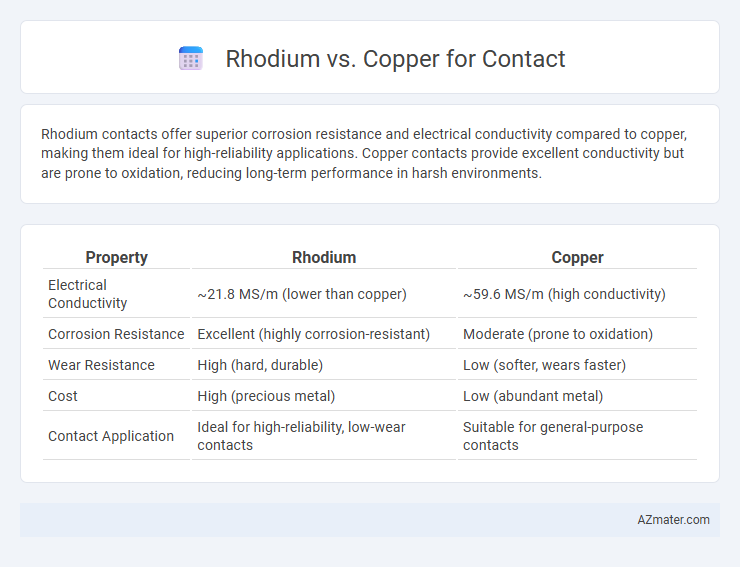Rhodium contacts offer superior corrosion resistance and electrical conductivity compared to copper, making them ideal for high-reliability applications. Copper contacts provide excellent conductivity but are prone to oxidation, reducing long-term performance in harsh environments.
Table of Comparison
| Property | Rhodium | Copper |
|---|---|---|
| Electrical Conductivity | ~21.8 MS/m (lower than copper) | ~59.6 MS/m (high conductivity) |
| Corrosion Resistance | Excellent (highly corrosion-resistant) | Moderate (prone to oxidation) |
| Wear Resistance | High (hard, durable) | Low (softer, wears faster) |
| Cost | High (precious metal) | Low (abundant metal) |
| Contact Application | Ideal for high-reliability, low-wear contacts | Suitable for general-purpose contacts |
Introduction to Rhodium and Copper Contacts
Rhodium contacts offer exceptional corrosion resistance and high electrical conductivity, making them ideal for high-performance electronic applications. Copper contacts, known for their excellent electrical and thermal conductivity, are widely used in general electrical connectors but are more prone to oxidation and wear. Choosing between rhodium and copper depends on the specific application requirements, including durability, conductivity, and environmental conditions.
Electrical Conductivity: Rhodium vs Copper
Copper exhibits superior electrical conductivity, approximately 5.96 x 10^7 S/m, making it one of the best conductors used in electrical contacts. Rhodium, however, with a conductivity around 2.3 x 10^7 S/m, offers lower conductivity but excels in corrosion resistance and durability. The trade-off between copper's high conductivity and rhodium's robustness often guides selection for specific electrical contact applications.
Corrosion Resistance Comparison
Rhodium exhibits superior corrosion resistance compared to copper, making it highly effective in environments exposed to oxidation and harsh chemicals. Copper readily oxidizes, forming a patina that can degrade electrical conductivity over time, whereas rhodium maintains stable performance due to its inert nature. This enhanced corrosion resistance makes rhodium a preferred choice for high-reliability electrical contacts and connectors in demanding applications.
Durability and Wear Life
Rhodium offers superior durability and wear life compared to copper due to its hardness and resistance to corrosion, making it ideal for high-performance electrical contacts. Copper, while highly conductive, oxidizes and wears faster under mechanical stress, leading to reduced contact reliability over time. Rhodium's exceptional resistance to abrasion and chemical degradation ensures longer-lasting, stable connections in demanding electrical applications.
Cost and Economic Considerations
Rhodium contacts, while offering superior corrosion resistance and conductivity, come with significantly higher costs compared to copper due to the metal's rarity and complex refining process. Copper contacts provide a cost-effective solution with excellent electrical conductivity, making them ideal for large-scale applications where budget constraints are critical. Choosing between rhodium and copper contacts depends on balancing upfront material costs with long-term durability and performance requirements.
Typical Applications in Electronics
Rhodium is widely used in high-reliability electronic contacts such as in precision connectors, switches, and relays due to its excellent corrosion resistance and superior conductivity under harsh conditions. Copper remains the preferred choice for general-purpose electronic contacts and circuit boards, offering outstanding electrical conductivity and cost-effectiveness in applications like printed circuit boards (PCBs) and electromagnetic components. The key differentiation lies in rhodium's durability in high-wear environments versus copper's efficiency and affordability in standard electronic applications.
Performance in High-Temperature Environments
Rhodium exhibits superior performance compared to copper in high-temperature environments due to its exceptional oxidation resistance and stable electrical conductivity at elevated temperatures. Unlike copper, which tends to oxidize and degrade, rhodium maintains low contact resistance and exceptional durability under thermal stress. This makes rhodium the preferred material for electrical contacts in applications requiring long-term reliability and minimal signal loss in harsh thermal conditions.
Maintenance and Longevity Factors
Rhodium contacts exhibit superior corrosion resistance and lower contact resistance compared to copper, significantly reducing maintenance frequency and ensuring longer operational life in high-reliability applications. Copper, while cost-effective and highly conductive, requires more frequent inspection and replacement due to its susceptibility to oxidation and wear under electrical stress. The enhanced durability of rhodium-coated contacts translates to lower total maintenance costs and extended service intervals.
Environmental Impact and Sustainability
Rhodium offers superior corrosion resistance and electrical conductivity compared to copper, extending the lifespan of electrical contacts and reducing material waste. Copper's widespread availability and recyclability contribute to a lower environmental footprint, yet its higher oxidation rate often necessitates frequent replacements, increasing resource consumption. Sustainable contact materials balance performance and recyclability, with rhodium's durability minimizing environmental impact while copper's abundant recycling infrastructure supports circular economy goals.
Conclusion: Choosing Between Rhodium and Copper Contacts
Rhodium contacts offer superior corrosion resistance and longer durability compared to copper, making them ideal for high-reliability applications in harsh environments. Copper contacts provide excellent electrical conductivity and cost-effectiveness but may require frequent maintenance due to oxidation and wear. Selecting between rhodium and copper contacts depends on balancing performance needs, environmental factors, and budget constraints in specific electronic or electrical systems.

Infographic: Rhodium vs Copper for Contact
 azmater.com
azmater.com